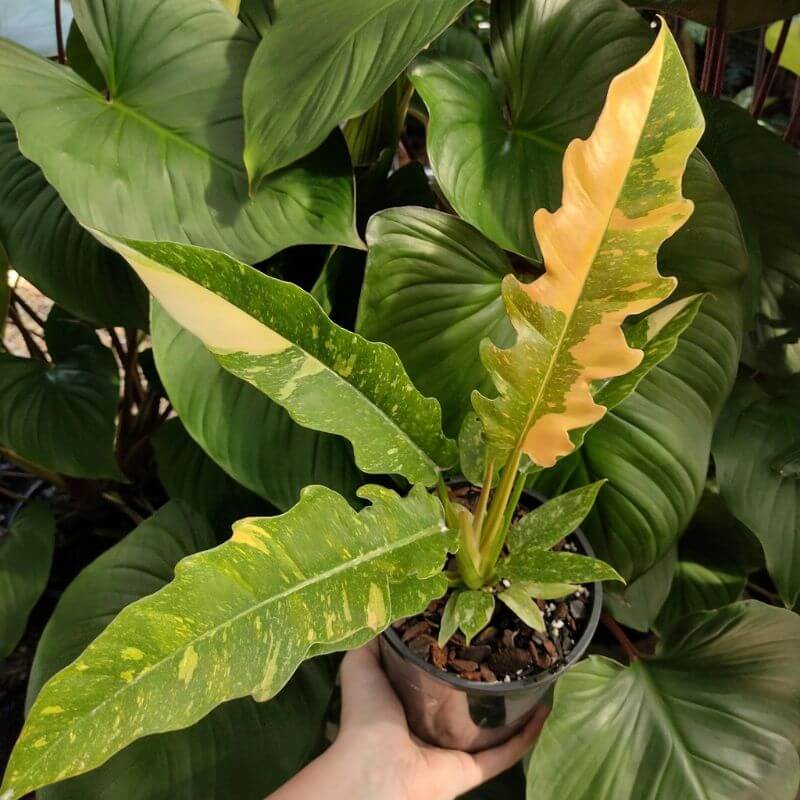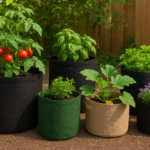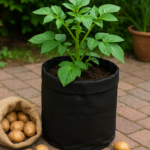Many gardeners and plant lovers like the stunning and well-liked Philodendron Ring of Fire. It is a fantastic option for bringing a hint of exotic charm to indoor areas because of its vivid colors and unique patterns.
Learn more about how to grow and care for this stunning plant.
What is a Philodendron Ring of Fire?

The Philodendron Ring of Fire is a special plant resulting from cross-breeding two other Philodendron species: the Wendlandii and tortum Philos.
It grows slowly and has a climbing habit.
The leaves are variegated which represent different colors like white, pink, red, or orange.
You can grow it on a moss pole or in a hanging basket, which makes it even more interesting.
Just like other Philodendrons, it helps clean the air, so it’s a great plant to have indoors.
Crystals of calcium oxalate, which are harmful if consumed, can be found in the variegated leaves. So it is toxic to pets and children.
Quick Overview of Philodendron Ring Of Fire
| Common Name | Philodendron Ring Of Fire (formerly Henderson’s pride) |
| Scientific Name | Philodendron wendlandii x P. tortum |
| Family | Araceae |
| Genus | Philodendron |
| Plant type | Perennial |
| Native Habitat | South America |
| USDA Hardiness Zone | 9-11 |
| Light | Bright indirect light |
| Soil | Well-draining, porous, slightly acidic |
| Temperature | 60-75°F |
| Humidity | Moderate |
| Water | Moderate |
| Fertilizer | Slow-release fertilizer |
| Pruning | Occasional |
| Repotting | Every two years |
| Toxic to Cats & Dogs | Yes |
| Toxic to Humans | Yes |
| Pests | Mealybugs, Aphids, Spider mites |
| Diseases | Root rot, Leaf Spot, Leaf Blight |
Philodendron Ring Of Fire Care

Light Requirement
The Ring of Fire is a tropical plant that thrives with direct morning sunlight but is not used to the intense rays of the afternoon sun, which can quickly damage its leaves and affect its watering requirements.
To provide the ideal lighting conditions, it is recommended to place the plant near windows facing east or west, as this will offer enough bright indirect light.
If you place the plant in a dim location and suspect that it lacks sufficient light, use artificial lights.
Temperature Requirement
To ensure optimal growth, maintain an average temperature range of 60-75°F for your Philodendron ring of fire.
Avoid exposing it to sudden temperature fluctuations and drafty areas.
Protect the plant from cold drafts, as exposure to cold air can cause damage to the foliage.
Keep it away from heating vents or radiators, as direct heat can dry out the plant.
Maintaining temperature within its preferred range helps promote healthy growth and prevents stress.
Humidity Level
Philodendron Ring of Fire prefers higher humidity levels.
You can increase humidity by misting the leaves regularly or placing the plant on a tray filled with water and pebbles.
Alternatively, a humidifier can help maintain the ideal humidity for the plant.
Another way to ensure a humid environment for your ring of fire is by placing it near other indoor plants, such as Anthuriums, pothos, and Monsteras.
Soil
Philodendron Ring of Fire prefers well-draining soil to prevent waterlogging and root rot.
A good soil mix of peat moss, perlite or pumice, and orchid bark is suitable for the Philodendron Ring of Fire.
This mixture provides adequate drainage while retaining enough moisture for the plant’s needs.
Avoid using heavy soils that retain too much water.
Drainage: Essential for Healthy Roots
Proper drainage is essential for the healthier and bushier growth of your plant.
Ensure that your chosen pot has drainage holes at the bottom to allow excess water to pass away.
Placing a layer of pebbles or broken pottery shards at the bottom of the pot can enhance drainage by preventing the soil from blocking the drainage holes.
You may also like
Watering Schedule
To maintain moist soil, water your philodendron ring of fire regularly.
A few things can help you to decide if it’s time to water your Philodendron ring of fire plant or not.
Finger Test: Insert your finger into the soil, about an inch or two deep.
If the upper 25% of the soil feels dry, it’s time to water your plant.
Soil Color: Another way to assess soil moisture is by observing the color Dark brown soil indicates higher moisture content, while lighter or dry-looking soil suggests the need for watering.
Moisture Meter: If you’re a beginner or find it challenging to measure soil moisture by touch or appearance, using a moisture meter can be helpful.
These devices provide precise readings and can save your plant from overwatering or underwatering.
During the winter season, cut back on irrigation to avoid overwatering.
On the other hand, during the hot summer months water it more frequently. Ensure the soil remains consistently moist but not waterlogged.
Fertilizing Requirement
Fertilizing the Philodendron Ring of Fire can help provide essential nutrients that promote healthy growth and vibrant foliage.
A balanced fertilizer ensures that the plant receives a well-rounded mix of nutrients.
During the active growing season, which typically spans spring and summer, you can fertilize the Philodendron Ring of Fire every two to four weeks.
This frequent fertilization helps support its growth and leaf production.
In contrast, during the dormant period in fall and winter, you can reduce the frequency to every six to eight weeks or even stop fertilization altogether.
Pruning Philodendron Ring Of Fire
Proper pruning helps maintain the plant’s shape, control its size, and promote healthy growth.
Regularly inspect your plant for any yellow or damaged leaves and trim them off with clean, sharp pruning shears.
Removing these leaves helps maintain the overall appearance of the plant and prevents potential disease or pest issues.
If your Philodendron Ring of Fire becomes too large or unruly, you can prune it back to the desired size or shape.
Choose a stem or branch just above a node (the point where leaves emerge), and make a clean cut using sterile pruning shears.
Pruning in early spring or late winter before the active growing season is often recommended.
If you desire a fuller, bushier plant, you can pinch off the tips of the stems. This encourages branching and leads to a denser growth habit.
Pinching can be done throughout the growing season, but be mindful not to remove too many tips at once, as it may stress the plant.
Repotting
Attention beginner growers!
The Philo Ring of Fire has an amazing repotting requirement.
After about 2 years, when it outgrows its pot and becomes rootbound, your Philo needs a new pot and fresh potting mix.
Take care not to damage the delicate roots when removing the plant from its current pot.
Clean the root ball, check for diseased roots, and remove them with sanitized pruners.
Use a pot that’s 2 inches larger, fill it halfway with the correct potting mix, and place your Philo in it.
Add more soil around the plant’s base and water it well.
Find a spot with sufficient bright indirect light.
Philodendron Ring Of Fire Plant Propagation

To expand your plant collection or share the beauty of these unique plants with others propagation is the easiest way.
There are a few methods you can use to propagate your Philo plant. All Philos, including Ring of Fire and Philodendron Fuzzy Petiole, can be propagated in a similar way, such as stem cutting and water propagation.
Stem Cutting Propagation
- Select a healthy stem from the parent plant that has at least two to three nodes (points where leaves emerge).
- Using clean and sharp pruners or scissors, make a clean cut just below a node leaving one or two leaves at the top.
- If desired, you can apply a rooting hormone to the cut end to promote root development (optional).
- Place the cutting in a container filled with a well-draining propagation mix, such as a combination of peat moss and perlite.
- Keep the soil consistently moist but not waterlogged and provide bright, indirect light.
- After a few weeks, you should start to see new roots forming.
- Once the roots are well-developed, you can transfer the cutting to a small pot with regular potting soil.
Water Propagation
- Select a healthy stem cutting, as described in the previous method.
- Fill a glass or jar with water and place the stem cutting in the water, ensuring that at least one or two nodes are submerged.
- Place the container in a location with bright, indirect light.
- Change the water every few days to prevent stagnation and the growth of harmful bacteria.
- Over time, you should see roots forming from the submerged nodes.
- Once the roots are well-established, you can transfer the cutting to a pot with well-draining soil.
Common Leaf Issues in Philodendron Ring Of Fire
Philodendron Ring of Fire, like other plants, can sometimes experience leaf issues that may indicate underlying problems.
Here are some common leaf issues you may encounter with the Philodendron Ring of Fire and their potential causes:
Yellowing Leaves
It can occur due to various reasons, including overwatering, underwatering, nutrient deficiencies, or natural aging.
Assess the plant’s watering routine and adjust accordingly, ensuring the soil is neither too dry nor waterlogged.
Consider fertilizing the plant with a balanced fertilizer to provide the necessary nutrients.
If the yellowing is limited to older leaves at the bottom of the plant, it may be a natural process as new leaves emerge.
Brown Spots or Edges
Brown spots or edges on the leaves can be caused by inconsistent watering, underwatering, or low humidity.
Check the soil moisture regularly and water the plant when the top inch (2.5 centimeters) of soil becomes slightly dry.
Increase humidity levels by misting the leaves or using a humidifier.
Avoid using water with high salt content, as it can cause leaf burn.
Leaf Curling
Leaf curling can be a response to dry air, low humidity, or inadequate watering.
Increase humidity levels around the plant by misting the leaves or placing a tray of water nearby.
Ensure the plant receives adequate watering, allowing the soil to dry slightly between waterings.
In some cases, curling leaves can also be caused by excessively high temperatures or direct sunlight, so adjust the plant’s placement accordingly.
Leaf Spotting or Discoloration
Leaf spots can occur due to fungal or bacterial infections.
Treat any visible pests with appropriate measures, such as insecticidal soap or natural predators.
For fungal or bacterial issues, consider using a fungicide or adjusting environmental conditions to discourage disease development.
Remove and dispose of severely affected leaves to prevent further spread.
Assess the plant’s conditions and adjust as needed, providing stable and suitable growing conditions.
Regularly inspecting your Philo plant leaves can help you identify and address any issues promptly.
Pests And Diseases of Philodendron Ring Of Fire
Philodendron Ring of Fire is generally a resilient plant, but like any other houseplant, it can be susceptible to certain pests and diseases.
Here are some common pests and diseases that may affect the Philodendron Ring of Fire plant.
Pests
1. Aphids: Aphids are small, soft-bodied insects that can gather new growth, causing curling and distortion. They can be found clustered on new growth, undersides of leaves, or along stems.
Use a strong stream of water to wash off aphids from the plant. Alternatively, you can apply insecticidal soap or neem oil following the product instructions. Repeat treatments may be necessary to fully eliminate the infestation.
2. Spider Mites: Spider mites are tiny pests that can cause webbing on the leaves and damage the plant by piercing the cells and sucking out the sap.
Regularly misting the leaves to increase humidity can help deter spider mites. If an infestation occurs, you can use insecticidal soap, neem oil, or horticultural oil following the product instructions. Ensure thorough coverage, targeting the undersides of leaves.
3. Mealybugs: Mealybugs are small, cotton-like insects that gather in clusters. They can be found on leaf joints, leaf undersides, and along stems. Infested areas may appear white or have a sticky residue.
Remove mealybugs manually using a cotton swab dipped in rubbing alcohol or soapy water. For severe infestations, you can use insecticidal soap or neem oil following the product instructions.
Diseases
Here is a common list of diseases that your Ring of Fire Plant can be afflicted with.
Leaf Spot
Leaf spot diseases are fungal or bacterial infections that cause spots or lesions on the leaves. The areas may vary in color, including brown, black, or yellow, and can sometimes have a concentric ring pattern.
Remove and destroy any infected leaves to prevent the spread of the disease. Ensure proper air circulation and avoid over-watering to minimize moisture on the foliage. Applying a fungicide or bactericide following the product instructions can help manage severe cases.
Root Rot
Root rot is caused by overwatering or poorly draining soil, leading to the decay of the plant’s roots. Symptoms include wilting, yellowing leaves, and a foul odor from the soil.
Address root rot by improving drainage conditions. Allow the soil to dry out slightly between waterings and ensure the pot has adequate drainage holes. Trim any affected roots and repot the plant using fresh, well-draining soil.
Leaf Blight
Leaf blight is a fungal disease that causes large brown or black spots on the leaves. Remove affected leaves and ensure proper air circulation and soil drainage. Apply a fungicide if the blight persists.
By staying vigilant and taking prompt action when necessary, you can effectively manage and mitigate pest and disease issues in your beloved Philodendron Ring of Fire, ensuring its health and vibrancy.
Is Philodendron Ring Of Fire toxic?
As for toxicity, Philodendrons, including Ring of Fire varieties, contain calcium oxalate crystals, which can cause irritation if ingested.
When the mouth, throat, and digestive systems are irritated by the crystals, it creates symptoms like swelling and burning.
It is important to keep the Philodendron Ring of Fire, out of reach of children and pets to prevent accidental ingestion.
It is advised to seek medical assistance or call a poison control center right away if you believe someone has consumed any component of the plant or is showing symptoms after contact.
While the Philodendron Ring of Fire adds beauty to indoor spaces, it is essential to handle it with care and be aware of its toxic nature to ensure the safety of everyone in the household, including curious pets.
Where to Buy Philodendron Fuzzy Petiole
If you want to buy Philodendron Fuzzy Petiole, you can purchase it both online and offline. Here several options are available to you:
Local Plant Nurseries
Visit your local plant nurseries or garden centers. They may have Philodendron Fuzzy Petiole in stock or be able to order it for you.
Online Plant Retailers
Explore online plant retailers that specialize in rare and exotic plants. Websites like Etsy, Amazon, eBay, and specialized plant shops often offer a variety of Philodendron Fuzzy Petiole plants for purchase.
Remember to read reviews, check seller ratings, and ensure that the plants are sourced ethically and shipped with care. Always choose reputable sellers to ensure the quality and health of your Philodendron Fuzzy Petiole plant.
Philodendron Jungle Boogie vs Ring of Fire
When comparing Philodendron Jungle Boogie and Ring of Fire, the most noticeable distinction lies in their coloring. While Jungle Boogie showcases vibrant green foliage, Ring of Fire boasts captivating shades of red, orange, and yellow.
Frequently Asked Questions (FAQs)
What is the scientific name of the Philodendron Ring of Fire?
The scientific name of the Philodendron Ring of Fire Is Philodendron wendlandii x P. tortum.
Is philodendron Ring of Fire rare?
The philodendron Ring of Fire is considered a relatively uncommon variety within the philodendron family. It is highly sought after by plant enthusiasts due to its unique characteristics and vibrant foliage.
What Colour is the philodendron Ring of Fire?
The philodendron Ring of Fire exhibits a captivating color palette in its foliage. The leaves typically showcase a deep green base color complemented by vivid shades of red, orange, and sometimes even pink or yellow. These striking colors contribute to its overall appeal.
How do you grow a philodendron Ring of Fire?
To successfully grow a philodendron Ring of Fire, requires indirect or filtered sunlight, well-draining soil, and a warm and humid environment. Water the plant when the top inch of soil feels dry, but be cautious not to overwater.
Is philodendron Ring of Fire fast-growing?
In terms of growth rate, the Ring of Fire philodendron is considered moderately fast-growing under optimal conditions.
Is Ring of Fire a climber?
Yes, the Ring of Fire philodendron is a climbing plant that can develop aerial roots and climb suitable support structures.
Is Ring Of Fire variegated?
No, the Ring of Fire philodendron is not typically variegated. Variegation refers to distinct patterns of different-colored areas on the leaves, and the Ring of Fire variety is primarily known for its vibrant and multi-colored foliage rather than variegation.
Conclusion
Discover the thrill of adding a rare plant to your collection. The Philodendron Ring of Fire is an extraordinary plant not to be missed if available. Follow our care advice to keep it happy and healthy!
Good Luck. Just go with the green!







